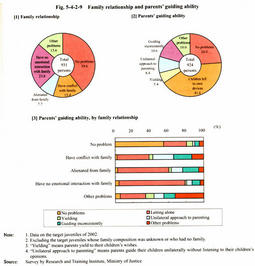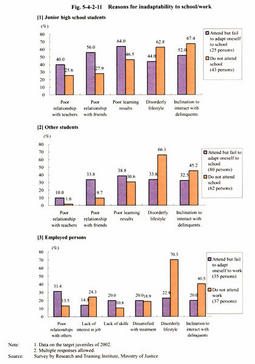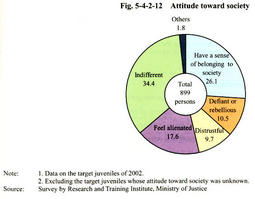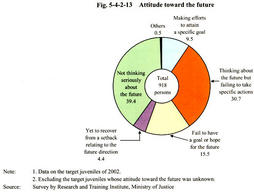| Previous Next Index Image Index Year Selection | |
|
|
3 Personal relationship and environment (1) Family relationship and parents' guiding ability As mentioned in Chapter 3, Section 2 , most juvenile robbery offenders have both parents, and this trend has also been revealed in this survey. Of the target juveniles, 58.6% had both parents, 21.5% had the biological mother only, 8.1 % had biological father only, 7.2% had a stepfather and the biological mother, and 1.9% had the' biological father and a stepmother.
Fig. 5-4-2-9 Family relationship and parents' guiding ability As for the family relationships of juvenile robbery offenders, which have been identified in the classification procedures, shown in Fig. 5-4-2-9 [1] , target juveniles who have "no problems" account for slightly below 40% while 60% have problems. "Have no emotional interaction with family" is the most common problem among them. "Have conflict with family" accounts for only about 15% whereas "have no emotional interaction with family" and "alienated from family" collectively account for more than 30%, twice as large as the percentage of "have conflict with family." This indicates that although the number of juveniles whose family has open conflict or direct confrontation between family members is not so large, many juveniles do not feel that they sufficiently belong to their family as a family member, and even in families that appear to be free from problems, the actual family relationship is often poor.As for parents' guiding ability, shown in Fig. 5-4-2-9 [2] , the target juveniles whose parents have "no problems" account for only a quarter whereas the percentage of "letting alone" was remarkably large. Among the target juveniles who have both parents, "no problems" accounts for only 30% while "children left to own devices" accounts for 30%, which clearly indicates a decline in parents' guiding ability. Fig. 5-4-2-9 [3] shows parents' guiding ability, by family relationship, indicating that in many cases in which the target juveniles have "no problems" with respect to the family relationship, the fact is that their parents fail to fully exercise their guiding ability as they "leave their children to their own devices" or "yield to their children's wishes." Among the target juveniles who "have no emotional interaction with family," the percentage of parents who "leave their children to their own devices" is extremely large. The percentage of "unilateral approach to parenting" is relatively large among those who "have conflict with family" compared with other groups, and the percentage of "guiding inconsistently" is slightly large among those who have "conflict with family" or are "alienated from family" compared with other groups. The number of the target juveniles whose family have open conflicts between family members is not so large whereas only 16.3% of the target juveniles have both parents and have no problem with parents' guiding ability or the family relationship. This suggests that the family system does not function sufficiently in the families of many juvenile robbery offenders. (2) Ability to adapt to society The trends in the educational/employment situation of juvenile robbery offenders has already been examined in Chapter 3, Section 2 . As shown in Fig. 5-4-2-10 , this survey has also revealed that employed juveniles account for 1/4th of the target juveniles, and unemployed juveniles and students account for half each of the rest. More specifically, slightly over 60% of students and 40% of employed juveniles cannot adapt themselves to school or work. Comparing junior high school students to others students, among junior high school students; those who attend and adapt themselves to school only account for 15.0% while those who attend but fail to adapt themselves to school and those who do not attend school account for 31.3% and 53.8% respectively whereas, among other students, those who attend and adapt themselves to school, those who attend but fail to adapt themselves to school, and those who do not attend school account for 43.0%, 32.1 %, and 24.9%, respectively., Generally, junior high school students are far less able to adapt to school. This may be due to the fact that junior high school is part of the compulsory educational stage and therefore applicable juveniles must go to junior high schools irrespective of their ability to adapt whereas, after completing the compulsory educational stage, those who cannot adapt themselves to school choose not go to higher school or go to high school but drop out.
Fig. 5-4-2-10 Adaptability to school/work Considering the adaptability to school/work in combination with the family environment mentioned above, only 7.3% of the target juveniles have both parents, have no problems with parents' guiding ability or family relationship, and belong and adapt themselves to school/work. Many juvenile robbery offenders belong but fail to adapt themselves to school/work. With the aim of preventing delinquency, it is necessary to take measures to ensure that juveniles adapt themselves to school/work as well as measures for unemployed juveniles.Fig. 5-4-2-11 shows reasons for inability to adapt to school/work, which have been identified in the classification procedures. Among the target juveniles who attend but fail to adapt themselves to school, as an inevitable consequence, the percentages of those who mention reasons relating to school life, such as "poor learning results," "poor relationships with friends," and "poor relationships with teachers," are larger than among those who do not attend school. Particularly among junior high school students, "poor learning results" and "poor relationship with friends" account for more than 60% and 50% respectively. Among juveniles who do not attend school/work, "disorderly lifestyle" and "inclination to interact with delinquents" are common reasons. This suggests that juveniles who attend but fail to adapt themselves to school because of lack of interest in study or friends at school gradually become inclined to interact with delinquents and have a disorderly lifestyle, and finally stop going to school. Such juveniles who have dropped out of school fail to get jobs and finally become unemployed juveniles, or if ever they get jobs, they cannot correct their disorderly lifestyle and stop going to work, and finally become unemployed juveniles again. Fig. 5-4-2-11 Reasons for inadaptability to school/work (3) Delinquent records Of the target juveniles, 23% were under tentative supervision, probationary supervision, or in welfareinstitutions at the time of committing the delinquent act concerned, 26.1% had previously been placed under probationary supervision before committing the delinquent act concerned, and 6.7% had previously been admitted to juvenile training schools before committing the delinquent act concerned. Even among juveniles who have committed the heinous offense of robbery, there are not so many juveniles who had previous dispositions. However, including juveniles who have voluntarily confessed to previous delinquent acts that had not been revealed until the time of classification, the percentage of juveniles who had never committed a delinquent act before was only 10.1 %.
(4) Attitudes toward society Fig. 5-4-2-12 shows the attitudes of juvenile robbery offenders toward society, which have been identified in the classification procedures. Those who "have a sense of belonging to society as a member of society" account only for about 1/4th of the target juveniles, which suggests that there are not so many juveniles who actually feel that they belong in society. Among these target juveniles who lack a sense of belonging in society, those who are "defiant of or rebellious against society" and those who are "distrustful of society" collectively account for about 20%, those who are "indifferent to society" account for more than 30%, and those who "feel alienated from society" account for slightly less than 20%. Juveniles who do not have a sense of belonging to the existing society due to defiance to or distrust of society existed in the past. However, at present, many juveniles are merely indifferent to the society surrounding them, without feeling such defiance or distrust. These juveniles and juvenals who feel alienated from society collectively account for more than 50%, which reveals an actual condition of juveniles who feel that where they live everyday life is distant from the real society. By adaptability to school/work, the percentage of the target juveniles who have a sense of belonging to society is largest, but it accounts for only 60% among those who attend and adapt themselves to school, followed by the percentage among those who attend and adapt themselves to work at 50%. The percentage is only about 10% among those who do not attend work or those who are unemployed.
Fig. 5-4-2-12 Attitude toward society Fig. 5-4-2-13 Attitude toward the future Fig. 5-4-2-13 shows attitudes of juvenile robbery offenders toward the future, which have been identified in the classification procedures. Those who are "making efforts to attain a specific goal" for the future account only for under 10% whereas those who are "not thinking about the future seriously" account for nearly 40% and many juveniles "fail to have a goal or hope for the future." This indicates that a lot of juveniles fail to give consideration to the future or recognize that the present leads to the future. By education/employment situation, the percentage of the target juveniles who are making efforts to attain a specific goal is largest among those who attend and adapt themselves to school, but they just account for about 1/4th, followed by the percentage among those who attend and adapt themselves to work, which only accounts for 20%. On the other hand, among the target juveniles who do not attend school or work and those who are unemployed, the percentage of those who are not thinking about the future seriously accounts for more than half. |




